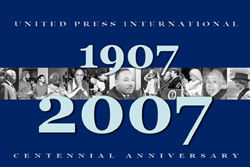1907 - 1910
1911 - 1920
1921 - 1930
1931 - 1940
1941 - 1950
1951 - 1960
1961 - 1970
1971 - 1980
1981 - 1990
1991 - 2000
2001 - Today
|
 |
UPI Archives
Tuesday, April 29, 1986
(Note: Unconfirmed reports of 2,000 dead, mentioned in lead paragraph, never were confirmed. See note in 6th paragraph that World Health Organization in 1995 said 30 people had been killed as immediate result of the Chernobyl accident.)
Chernobyl reactor still burning
By G. LUTHER WHITINGTON
MOSCOW, April 29, 1986 (UPI) - The Soviet Union said today the nuclear accident at its giant power plant north of Kiev was a ''disaster'' and that two people were killed. An unconfirmed report from the area said the death toll may have surpassed 2,000. (Editor's note: The report of the 2,000 deaths never was confirmed).
Earlier today, nuclear energy officials in West Germany and Sweden said Soviet officials had asked for advice on how to put out an atomic fire, which is considered more disastrous than a reactor core meltdown. The European officials speculated the reactor was burning out of control.
A Kiev resident, who has close contacts with hospital and rescue officials, told United Press International in a telephone interview that between 10,000 and 15,000 people had been evacuated from Pripyat, site of the Chernobyl nuclear reactor.
''Eighty people died immediately and some 2,000 people died on the way to hospitals,'' the Kiev resident said. ''The whole October Hospital in Kiev is packed with people who suffer from radiation sickness.''
It was not possible to immediately confirm the Kiev woman's reports. (Editor's note: The woman's report of 2,000 dead never was confirmed. The World Health Organization in 1995 said 30 people were killed at the reactor site as an immediate result of the accident and 200 were hospitalized).
Official Moscow radio said tonight that two people were killed by the accident and the Soviet news agency Tass said residents of three settlements around the plant were evacuated.
''The necessary medical aid is being given to those affected,'' the official news agency said. ''The state of the radiation situation ... and the adjacent territory is being monitored continuously.''
The woman in Kiev said, ''The people were not buried in ordinary cemeteries but in the village of Pirogov, where radioactive wastes are usually buried.'' ''It so horrible and sad. The whole city is discussing it. Everything possible is being done to help the people.''
She said as many as 15,000 Pripyat residents had been evacuated by bus and military planes and helicopters to Kiev, the Soviet Union's third largest city with 2.3 million people.
Other Soviet sources said the report on Moscow radio indicated the accident at the Chernobyl plant, 80 miles north of Kiev, caused a catastrophic loss of life. A Soviet diplomat called it history's worst nuclear accident.
Tass said preliminary reports indicated the accident occurred ''in one of the areas of the fourth power-generating unit,'' destroying part of the building housing the reactor and allowing radioactive material to leak.
''The three other power-generating units have been shut down. They are in order and in operational reserve,'' it said.
In Stockholm, Friedrich Reich of the Swedish nuclear inspection authority told Swedish radio, ''They asked for advice on how to put out a reactor fire. It is probably the moderator that is on fire. It is a graphite-moderated reactor. Graphite burns like coal.''
Reich said he advised the Soviets to contact Britain, which he said had a graphite fire at its Windscale nuclear reactor in 1957.
In Bonn, West Germany, Manfred Petrowl, spokesman for the German Atom Forum, said a Soviet diplomat visited the forum's office and asked how to fight a graphite fire.
The forum is not a government organization but a private association that advises West German industry on nuclear matters. The West German government also offered Moscow help, a West German Foreign Ministry spokesman said.
State-run Radio Moscow today called the accident at the giant nuclear power complex, which spread radioactive material across Scandanavia some 1,000 miles to the northwest, a ''disaster'' and admitted it was not the first in Soviet atomic history.
''The disaster was the first one at a Soviet nuclear power plant in more than 30 years,'' Radio Moscow said, apparently referring to an accident in 1957 that destroyed several villages in the Soviet Union's eastern Ural mountains.
It was the first time the Soviet Union has admitted there was a nuclear accident prior to Chernobyl.
''Drastic measures are being carried out to guarantee the power reactor's reliability and safety,'' the radio said. ''Nevertheless, our observers point out, this accident and others at nuclear power stations in the West show that nuclear power, even when used for peaceful purposes, can be dangerous.''
One Western diplomat said it was impossible to assess the report of 2,000 people dead but said ''the figure is in the ballpark of rumors coming from the Ukraine.''
Several Western embassies reported that Westerners had phoned from Kiev to say up to 3,000 people were dead but embassy spokesmen said they considered the reports rumors.
''It is impossible to assess this report,'' one Western diplomat said. ''On the one hand it is a rural area but on the other hand about 50,000 people live in the area. It is not impossible. It is a chilling report.''
A spokeswoman at October Hospital denied in a telephone interview the facility was treating people injured in the accident.
The United States offered aid to the Soviets but White House Chief of Staff Donald Regan said in Guam that Moscow had not requested U.S. help. ''We could be helpful and would be if asked,'' Regan said.
Experts agreed a fire is worse than a meltdown at a nuclear reactor.
''Obviously it's very serious. You've got four reactors in that atomic power plant,'' a diplomat said. ''Three don't have any containment (which prevents escape of contamination). If you've got a fire in one of those reactors it could lead to a meltdown.
''Fire could be worse than a meltdown because it sucks more air in and then spews the stuff out,'' he said. ''Fire means more contamination.''
''The Soviets didn't start putting containment vessels on until 1979 and two of those Chernobyl reactors were put on line before 1979,'' said Scott Peters, a spokesman at the Atomic Industrial Forum, a non-profit international trade association.
Paul Leventhal of the Nuclear Control Institute, a non-profit organization that studies nuclear proliferation questions, said: ''Without containment vessels ... the consequences could be catastrophic.''
The worst U.S. commercial nuclear accident occurred March 28, 1979, when a small amount of radiation escaped from Three Mile Island nuclear power plant near Harrisburg, Pa. About 144,000 people were evacuated but no one was injured.
The worst previous accident occurred in the Soviet Union in 1957 but the Soviet Union has never explicitly acknowledged it. The explosion of nuclear waste turned some 30 villages into ghost towns.
American experts said many Soviet plants lack reactor containment structures that could limit the damage caused by a leak of radioactive material a reactor core meltdown.
A Soviet diplomat in Helsinki, Finland, said the disaster at the plant was ''the worst ever in the world.'' The Chernobyl nuclear plant is located in the heart of the Soviet ''bread basket,'' where most of the nation's food is produced.
The plant is in the town of Pripyat, a settlement of 25,000 to 30,000 construction workers, plant personnel and their families, that was built along with the Chernobyl plant in the 1970s, The New York Times said today.
There were reports drinking water had been contaminated but diplomats said this could not be confirmed. Residents of Kiev, capital of the Ukraine, said today all bus service in the city was stopped so vehicles could be used to evacuate the accident area.
''Most people weren't aware of it until the TV news,'' a teacher said. ''I hope we know more tomorrow.''
The accident sent the radioactive cloud drifting north from Chernobyl over Leningrad, the nation's second largest city, and then on to Scandinavia, where nuclear power first learned of the accident inside the Soviet Union.
Scandinavian officials reported elevated radiation levels but said they posed no immediate danger. The radiation cloud was moving north on a polar route that the U.S. Environmental Protection Agency said could take it to the West Coast of the United States in five or six days. White House spokesman Larry Speakes said, ''We understand there is no danger to the United States.''
Polish television reported today the radioactive cloud also passed over northeastern Poland but that it was not a health hazard.
Western embassy spokesmen in Moscow today expressed concern about their nationals in the accident area and said attempts to reach them had proved futile.
The Soviet tourist agency, Intourist, said no tours were being canceled.
''We have no official Americans -- no students or professors -- in the Ukraine right now,'' a U.S. Embassy spokesman said. ''It is possible that there are tourists. You can assume that we are concerned and interested.''
The Council of Ministers statement carried Monday by Tass, the official news agency, said a reactor had been damaged at the Chernobyl plant and ''measures have been undertaken to eliminate the consequences of the accident.'' It did not elaborate.
But the Communist Party newspaper Pravda did not report the accident today and there was no update on radio or television news. The Sunday edition of the main paper from the accident region, Pravda Ukraina, which reached Moscow today, made no mention of the accident and no obituaries were published.
The brief statement on the accident from the Council of Ministers was read on the nightly television news program, Vremya, watched by millions of people -- a further indication that casualties were extensive.
The accident first came to light after a worker at the Swedish Forsmark nuclear power plant set off an alarm Monday morning when his clothes registered unusually high radiation levels.
Authorities quickly evacuated 600 employees, but experts could not explain the occurrence until radiation readings were taken in other parts of Sweden.
Swedish energy board spokesman Olle Blomquist said the radiation levels detected were ''unharmful for people but clearly unallowable.''
Copyright 2007 by United Press International.
|


